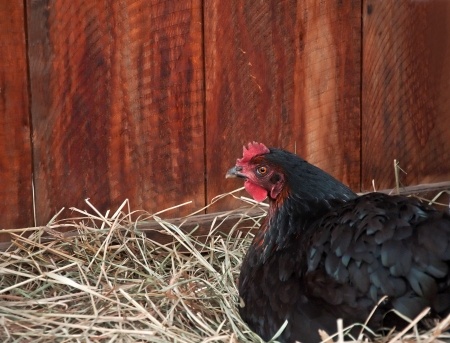
Have you noticed one of your hens waddling like a penguin? Is she going in and out of her nest box without laying? Is she struggling to defecate? Does her abdomen feel hard to the touch? Your hen may be egg-bound. This is a potentially life-threatening condition wherein an egg becomes trapped between the Uterus and Cloaca. An egg-bound hen is prone to infection and internal damage, and can even die within 48 hours if she’s unable to defecate. Likewise, it’s essential that we take steps to free stuck eggs as soon as we notice one of our hens is egg-bound.
The Exam
First, you’ll need to verify whether or not your hen is, in fact, egg-bound. To do so, you’ll need a latex glove and a lubricant such as Vaseline. Coat your index finger in the lubricant and gently insert it into the hen’s vent. If an egg is stuck, it will likely be within 1 to 2 inches of her vent. As you insert your finger into her vent, gently press on her abdomen with your other hand. If you don’t feel an egg touch your finger, then the hen is not egg-bound. If you do feel an egg, then you’ll need to remove it quickly.
The Extraction
First, coat the inside of the hen’s vent with lubricant. Then, with your finger still in the vent, gently massage the hen’s abdomen with your free hand. Sometimes this added lubrication and gentle massaging action will be enough to free the stuck egg. If this technique doesn’t succeed in freeing the egg, you’ll have to move on to plan B.
Calcium supplements can sometimes facilitate the muscle contractions needed to remove a stuck egg. Grind up a Tums or human calcium supplement and mix it with feed for your chicken. Once she’s eaten the calcium, you can try soaking her lower half in a tub of warm water for 10 to 15 minutes. The warm water in conjunction with the calcium can help to further relax the abdominal muscles, allowing the egg to pass more easily. If she has not passed the egg within an hour, repeat the process and try again.
Breaking the egg within the hen should be avoided at all costs, as this can cause damage to the inside of her oviduct. If you the egg fails to pass and you’re forced to break it, do so by first gently inserting a syringe without a needle into the egg to remove its contents. Then, carefully break the shell into pieces and remove them one by one. In order to ensure all the shell fragments have been removed, you can use a turkey baster to flush the hen’s oviduct with water. Once you’ve removed the egg, you can apply Preparation H to your hen’s vent to reduce inflammation. Keep the hen separate from the rest of the flock until she has recovered completely.
Want to learn more about caring for your chickens? Give us a call and we’ll do our best to answer any of your questions. From the CACKLE COOP!



my chickens abdomen is swollen and soft.